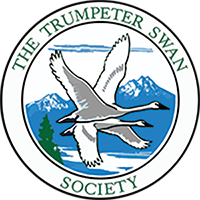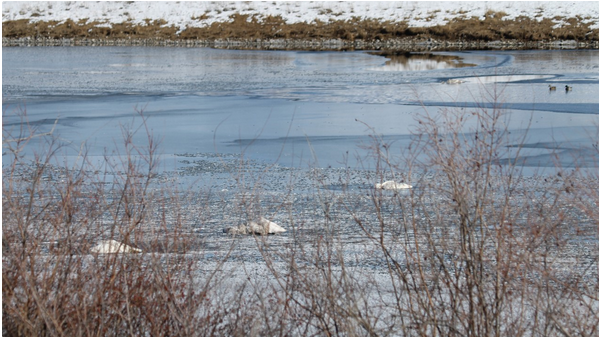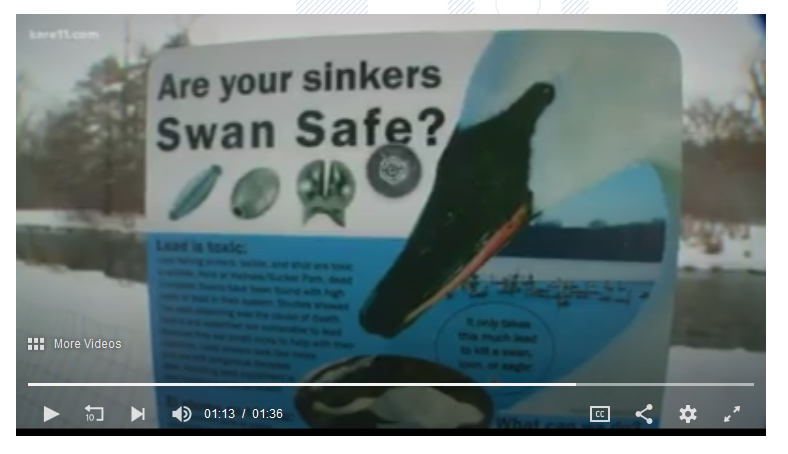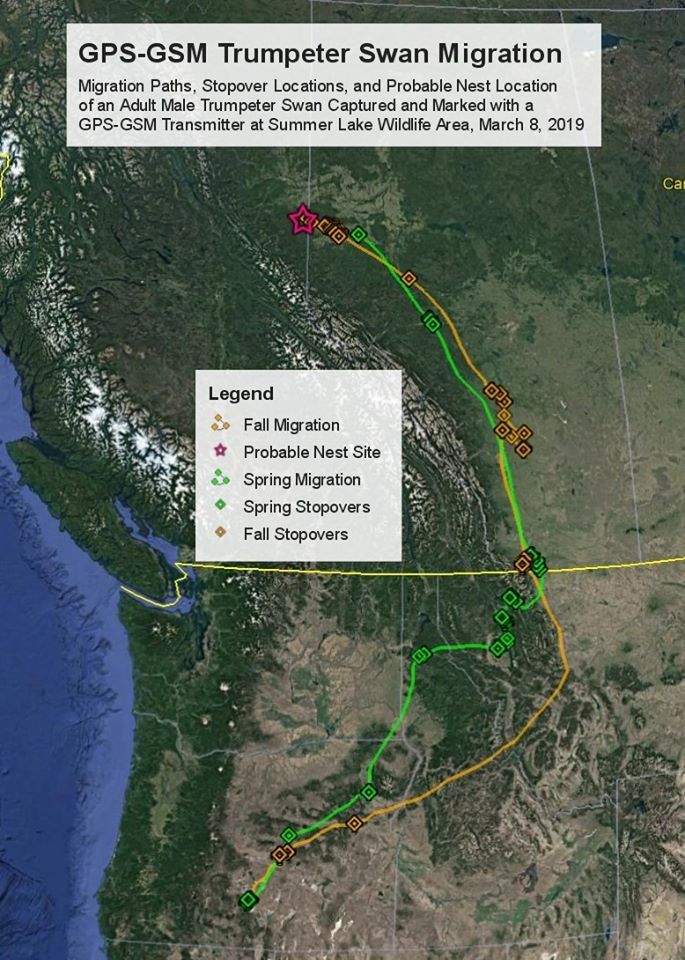Photograph by Margaret Smith
2020 TTSS News Archive
News Highlights from 2020
UTAH: "Salt Lake City — The swan hunting season was closed in Utah 16 days early after the federal quota of 20 trumpeter swans was met on Nov. 27. This is the second consecutive year that the swan hunt had to be closed early.
Starting tomorrow — Saturday, Nov. 28 — hunters are prohibited from killing any swan in Utah.
The 2020 swan hunting season opened on Oct. 3 and was scheduled to run until Dec. 13, but was closed after the 20th trumpeter swan was harvested. Previously, the limit for trumpeter swan harvest in Utah was set at 10 swans, but the U.S. Fish and Wildlife Service increased that number to 20 swans in 2019.
"This is the second year in a row that we have seen a higher number of trumpeter swans harvested because there were more migrating through Utah than in previous years," Utah Division of Wildlife Resources Migratory Game Bird Program Coordinator Blair Stringham said." Read more...
IDAHO: Great article about the differences between trumpeter swans, tundra swans, snow geese and sandhill cranes. "The large migration of Tundra swans and Snow geese usually happens in October when both species head for Mexico and a few southwestern states for the winter. Tundra swans usually nest just below the Arctic Circle, while most Snow geese nest above the circle.
Most of the large white birds that are feeding in area fields are the Trumpeters that spent the summer in Alaska or in scattered pockets in Canada. Most of them will stay here in the Upper Snake River Valley, feeding in harvested fields — or in the case at Deer Parks Management Area — grains that were planted for them and not harvested. Many will spend the winter feeding on the aquatic plants on the Henrys Fork of the Snake River and Teton River unless icing conditions force them to the lower valleys." Read more...
MINNESOTA: Trumpeter swans are beginning their migration to wintering areas. Read more...
WISCONSIN: "After the illegal shooting of a protected trumpeter swan near Hudson earlier this month, the Wisconsin Department of Natural Resources (DNR) reminds hunters to be sure of their targets before firing overhead.
With the waterfowl season underway and goose season open through early January, it’s critical for hunters to know the difference between waterfowl species legal to hunt and other big white birds that are not legal to hunt in Wisconsin.
All wild swans are protected in Wisconsin. It is illegal to hunt native trumpeter swans, tundra swans and non-native mute swans in Wisconsin. Other large white birds, including American white pelicans and whooping cranes, are also illegal to hunt." Read more...
IOWA: "Their return from the brink of extinction is one of the 20th century’s most amazing success stories, and the story continues yet today. It’s all the more interesting because Carroll Henderson, a Minnesota wildlife biologist who grew up here in Story County and a long-time acquaintance, played an important roll in making the story possible." Read more...
MARYLAND: "BALTIMORE (WJZ) — Three swans are on their way to their new home after being rehabilitated at the Maryland Zoo in Baltimore." Read more...
IOWA: 51 trumpeter swans received collars this summer – nine adults received GPS units and 42 cygnets received green, numbered neck collars. This is the first time the Iowa DNR has place GPS tracking devices on trumpeter swans.The Iowa project is part of a larger population wide movement study on the interior population of trumpeter swans that is being led by the University of Minnesota Cooperative Fish and Wildlife Research Unit and involves six states and provinces that are part of the Mississippi Flyway Council — Minnesota, Wisconsin, Michigan, Iowa, Manitoba, and Ohio. Read more...
WISCONSIN: The Wisconsin Department of Natural Resources put GPS collars on 5 Wisconsin trumpeter swans, part of the Midwest GPS swan tracking study. In 2021, 5 more Wisconsin trumpeter swans will be collared. "What we hope to do with this current study is to get more information on where they're stopping when they migrate, where are they actually all going, and when are they coming back and what kinds of habitats are they using on the way back," said Wisconsin Department of Natural Resources Avian Ecologist Sumner Matteson. "We'll get really a more complete ecological picture." Read more...
MINNESOTA: A rare Whooper Swan was spotted in southern Minnesota. The national bird of Finland, this species of swan is a Eurasian bird found primarily in places like Finland, Siberia or the Aleutian Islands near Alaska. It is not known why the swan is in Minnesota. Read more...
OREGON: From our partners at Sunriver Nature Center who are raising cygnets to support our Oregon Restoration Program. Facebook: "We said a bittersweet farewell to our three cygnets last week who will now be able to spread their wings and fly at their new home at Summer Lake Wildlife Area. There they join other cygnets hatched this year and last and will hopefully form the basis for a future breeding flock of Trumpeter Swans in Oregon." Read more...
IDAHO: "So, what about birders? Are male and female birders basically the same, toting bins, wearing bird T-shirts and ball caps, tromping through the woods, and all just seeking a good look at a familiar species or a glimpse of a rarity? Are we out there for the same reasons and taking the same treasures home? My research on birders in the United States suggests that, no, we are different in a lot of ways. Males and females see the birding world differently." Read more...
WASHINGTON: "While many travel Cultus Bay Road daily, most fail to notice the majestic white bird cruising the shallows of the far shore of the wetlands, feeding on grasses and water plants, preening or shaking water off his six-foot wingspan. A solitary Trumpeter Swan has made this home since fall of 2019." Read more...
The Washington Post: "A federal judge in New York has invalidated rule changes by the Trump administration that allowed individuals and corporations to kill scores of birds as long as they could prove they did not intentionally set out to do so.
In a blistering ruling that cited Harper Lee’s “To Kill A Mockingbird”, U.S. District Judge Valerie E. Caproni ripped the administration’s interpretation of “takings” and “killings” of birds under the century-old Migratory Bird Treaty Act as applying only if the animals are specifically targeted." Read more...
Congratulations to TTSS Executive Director, Margaret Smith. She recently was awarded the Wisconsin Invasive Crusader Award, one of 4 Wisconsin citizens to receive it in 2020. It’s given to Wisconsin citizens and organizations for significant contributions to prevent, control or eradicate invasive species. Margaret Smith has been a Wisconsin Master Gardener for more than 20 years and is a St. Croix Master Watershed Steward, sharing her passion and commitment to land and water conservation.
MONTANA: "For the second year in a row, the Lee Metcalf National Wildlife Refuge has a brood of trumpeter swan cygnets. The refuge’s manager, Tom Reed, said they were first spotted Sunday."
"Reed saw what appeared to be three cygnets Wednesday. They were near the same muskrat lodge a pair of trumpeter swans used last year to hatch the first documented wild trumpeter swan cygnets in the Bitterroot since restoration efforts began decades ago to bring the birds back from the brink of extinction in the lower 48 states." Read more...
OREGON: Six cygnets hatched to TTSS's Oregon captive swan breeding partner Aspen Lakes Golf Course in June. Later this year or next spring they will be released into the Oregon Restoration Project at Summer Lake Wildlife Area. They will be helping to restore Oregon's natural heritage. Read more...
MINNESOTA: A front row seat watching Trumpeter Swans become parents. This delightful article shares what it is like to watch a Trumpeter Swan pair arrive in early spring, build a nest, and successfully hatch cygnets. Read more...
WASHINGTON: Turnbull National Wildlife Refuge near Spokane has had trumpeter swans since the 1980s. "The swan is likely one of the 10 or so that lives at the refuge more or less year-round, refuge biologist Mike Rule said." Read more...
NEBRASKA: A beautiful 10 minute film and photos and essay showcase the story of Nebraska Sandhill's trumpeter swans. Not to be missed. Mike Forsberg presented portions of this at the 25th Swan Conference in Alton, Illinois in November 2019.
ALASKA: Migrating birds can now be seen at Creamer’s Field Migratory Waterfowl Refuge.
Geese have been spotted 100 miles away from Fairbanks and are expected soon. Wildlife Biologist Mark Ross said, "This is one of the sure signs of spring in Fairbanks. We've got trumpeter swans on the field, and geese are due any day because there's at least 25 or more 100 miles south of here...But by the end of the month we should have a thousand Canada Geese, many thousands of ducks, and we might break a swan record this year,” Ross said." Read more...
MINNESOTA: "...The other evening they came flying over the hill, gliding low over the pond ice and snow and splashed into the open creek, trumpeted some and swam upstream out of sight. I knew it...in a few minutes they were bugling nonstop as they came around the bend, wings splashing, and were airborne just as they got to the ice edge. They flew low, circled the pond as they slowly gained altitude to clear the surrounding hills. They’re showing off, I know they are!" Read more...
IDAHO: "ISLAND PARK, Idaho — With the days getting longer and warmer, many of us are anxious to leave our homes and head north. And the same is true for these elegant birds that spend their winters on the Henry's Fork of the Snake River, trumpeter swans. During winter, the birds flock to this area which includes Harriman State Park.
"It's exciting to see them," said Harriman State Park office specialist Kyle Babbitt. "I mean you can be twenty feet from them and they're swimming along and doing their thing, so you get to see them up close instead of just at a distance." Read more
WASHINGTON: "Among us in the San Juan Islands on our very own Orcas, we have a great treasure. We usually see this treasure during the winter. It is a handsome, black and white, five-foot-long bird called the trumpeter swan, otherwise known as cygnus buccinator. Trumpeter swans are superlative birds. This story, except for the introduction, is told by a cygnet, a baby swan in his trumpeter swan family." Read the story...
MINNESOTA: "The Minnesota Pollution Control Agency, with the help of the Department of Natural Resource’s nongame wildlife program, is set to launch a statewide public awareness campaign, “Get the Lead Out,” to persuade anglers to switch to nonlead tackle and sinkers to protect waterfowl." Read more...
IDAHO: "Deer Parks Wildlife Management Area west of the Menan Buttes is a hub of activity with nearly 1,000 Trumpeter swan, thousands of migrating ducks, hundreds of Canada geese, a few Sandhill cranes and huge flocks of blackbirds, all trying to find enough to eat." Read more...
IOWA:This is an excellent article about the restoration of trumpeter swans to Iowa and the importance of health wetlands to swan habitat and the habitat of more than 400 species.
MINNESOTA: You may have noticed trumpeter swans on Pleasant Lake or Teal Pond—their distinctive black bill against all-white plumage is a handsome and unique feature among their swan brethren. But did you know that these North Oaks residents are descended from Alaska?" Read more...
MONTANA: "BOZEMAN — Game wardens with Montana Fish, Wildlife & Parks are seeking information on several trumpeter swans that were shot east of Manhattan.
"The swans were discovered on Central Park Pond on Heeb Road. Initial analysis of the collected birds showed evidence that several of them had been shot illegally. The investigation is ongoing, and further testing on the dead birds is still pending.
"Investigators believe the birds were likely shot sometime around Feb. 19...Anyone with information on this incident is asked to call Montana’s poaching hotline, 1-800-TIP-MONT (847-6668). Informants can remain anonymous, and persons who provide information that leads to a successful prosecution in this case may be eligible for a monetary reward." Read more...
MONTANA: "Fans of the Bitterroot’s Valley first cygnets hatched in the wild in recent memory will be happy to learn they weren’t among the seven swans recently found dead near a pond in Bozeman." Read more...
WISCONSIN: (includes video). MADISON, Wis. (WMTV) -- The Madison Fire Department is asking anglers to stop using lead-based fishing tackles after a tundra swan was poisoned but survived and another swan died after swallowing such tackles on Lake Mendota.The Dane County Humane Society's Wildlife Center has never rescued a swan that was without lead poisoning. Experts have also seen lead poisoning in geese, ducks, turtles, opossums and eagles.
"The best thing we could do to stop finding these swans and geese and other animals with lead poisoning, is to stop using lead as much as we possibly can," Collins explains.
The burden now falls on hunters and fishers to find alternatives to lead shots or lead sinkers. Such a change could protect more than area wildlife.
"If lead is accumulating in the environment in small amounts, in fish and water fowl and other animals that pick it up from the environment, that lead could be transferred to people who consume those animals," Collins tells NBC15 News... Read more
IDAHO: Trumpeter Swans can be seen year round at Harriman State Park. "While snowshoeing down the groomed trail at Harriman State Park on a February day, you immediately notice the whispering notes from wind rustling through lodgepole pines combined with the silky sounds of the rippling waters of the Henrys Fork of the Snake River.
But Nature’s symphony really doesn’t build to a crescendo until you take in the deep trumpeting of the park’s renown trumpeter swans." Read more...
WASHINGTON: September rains and mud-soaked fields left many NW WA potato farmers with unharvested potato fields. "The Washington Department of Fish & Wildlife estimates 20,000 trumpeter swans, with a few tundra swans mixed in, are wintering in the Skagit River delta region. Local birders who monitor the area estimate that upwards of 90% of the swans this year are feeding exclusively in the potato fields. " Read more...
IOWA: Over 400 people attended the West Des Moines Iowa Swan Soiree on February 15. They learned about the return of trumpeter swans to Iowa, a fascinating story... Read more...
MINNESOTA: TV station KARE 11 brought attention to the swan deaths at a local Twin Cities lake, where at least a dozen swans have died over the past year from suspected lead poisoning. The lake is heavily fished and lead fishing tackle is the suspected cause for the poisoning. Watch the video...
MINNESOTA: "Trumpeter swans continue to die of suspected lead poisoning at a lake in the Twin Cities metro area.
Last year, 11 of the majestic swans were found dead at Vadnais Lake in Vadnais Heights. This winter, two additional trumpeter swans have been located deceased at the lake, including one on the lake's north end/east side, and another at Sucker Channel. " Read more...
INDIANA: "While photographing the trumpeters at some distance this past August, I noticed the yellow colored legs on one of the birds and assumed it was a juvenile. I was told at the headquarters at Willow Slough this past week that the swan with yellow legs was believed to be leucistic." Read more...
CANADA: The 1955 article from the Canadian History archives shares the story of the trumpeter swan and early efforts to protect it and restore it in western Canada near Grande Prairie. Read more...
CANADA: "In the Winter 1955 edition of The Beaver, a feature article created by husband-and-wife team Richard and Lyn Harrington gave a first-hand look at the lengths to which some people in Canada and the United States were going to keep the trumpeter swan alive." Read more...
WISCONSIN: "Three of our iconic Northwoods bird species are being killed by lead picked up during feeding activities. They are the American bald eagle, the common loon, and the trumpeter swan. Lead also takes a toll on at least 12 other Wisconsin bird species." Read more...
ONTARIO: " Mandatory ice water training on Thursday for an Orillia Fire Department platoon quickly turned into an actual ice-rescue of a Trumpeter Swan.
When the swan was found frozen in the icy grip of the Trent Severn Waterway 40 feet from shore, the crew jumped in to help." Read more...
OREGON: Update from our Oregon Restoration Program (from Oregon Department of Fish and Wildlife Facebook page)
Can you believe this trumpeter swan stayed airborne for 12 hours while flying from southern Alberta to a small reservoir near Unity, Oregon? With a six-and-a-half foot wingspan, trumpeter swans travel great distances to breed.
We captured and GPS-collared the male swan at Summer Lake Wildlife Area nearly a year ago. On March 11, he left for summer breeding grounds, spending over five months near a pond in the Peace River Region of British Columbia. This area is one of the core breeding areas for the Rocky Mountain population of trumpeter swans. On September 21, he moved east to the vicinity of Grande Prairie, Alberta, staging for a month before migrating back to the wildlife area.
Based on its daily movements during the summer, biologists believe the swan and his mate nested hatched a brood. Unfortunately, if that was the case, the cygnets didn’t survive as we have only spotted the male and his mate at the wildlife area. Low survival of cygnets – young swans – is typical of this bird, an Oregon Conservation Strategy Species.
We continue to monitor this swan’s movements and will conduct our winter trumpeter swan survey soon. We also hope to capture and GPS collar four more trumpeter swans this winter at the wildlife area. ODFW works with The Trumpeter Swan Society and others to restore trumpeter swans to their native range in Oregon.
IOWA: "Wintering populations of Trumpeter Swans are increasing annually all across Iowa thanks to restoration efforts of the species by wildlife management personnel across the continent."
"Throughout this fall and up until recently as many as 20 Trumpeter Swans have been residing at Sand Lake. While they spend much of the day at the lake, the birds will fly to picked corn fields to feed during the mornings and evenings. Although very cold weather tolerant, this latest bout of cold and snowy weather will determine if they migrate to points further south." Read more...
WASHINGTON: "Enjoy the 'white wings of winter' in the North Olympic Peninsula, and rejoice at the successful recovery of the North American trumpeter swan populations. Read more...
VIDEO: Trumpeter Swans are largely vegetarians, feeding on aquatic plants, roots and tubers, and some small invertebrates as well. But do they eat fish? Not very easily and not very often. Learn more...








